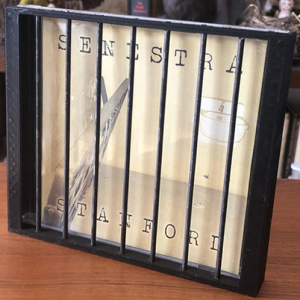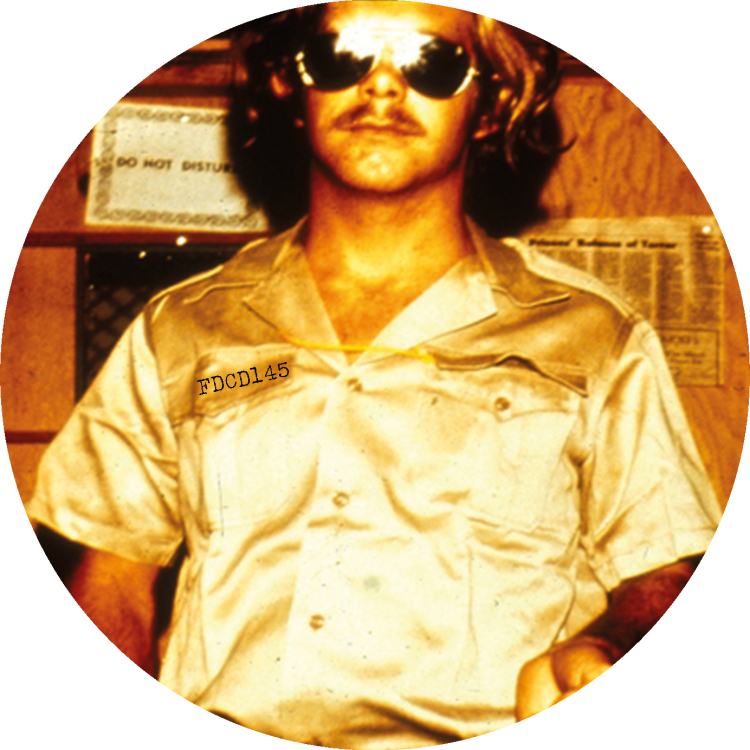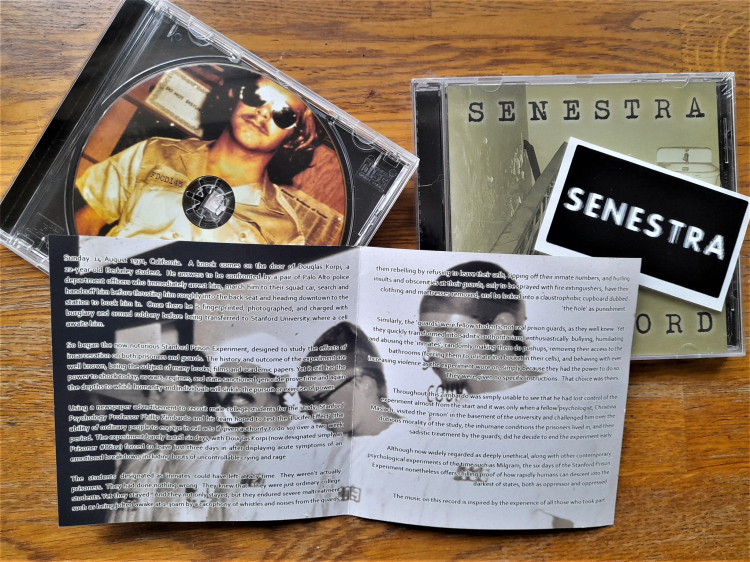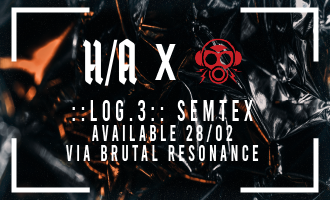Senestra - Stanford

Sometimes the most random thing can trigger a memory that has been locked away somewhere in the endless labyrinth of the mind. A scent, a word, something you see can instantly transport you back to that very moment, almost like time travel for a brief moment only to vanish again. This was the case when I received this for review. I saw the Stanford Prison Experiment mentioned and without any research, I was transported back to my early days in high school and college. I remember the endless studies in general psychology classes such as B.F. Skinner's approach to radical behaviorism when he challenged the idea of free will for reinforcement using rats to demonstrate conditioning for a desired response, food or electric shock in the "Skinner box". Another experiment that stood out was the Milgram Experiment where people were tested to see how far they would go to comply with commands of an authority figure. Harry Harlow's study of childhood development through the use of newborn rhesus monkeys being separated from their mothers at birth. The study showed the importance love played on healthy childhood development. This brings us to the theme Senestra focuses on for their debut album. In order to fully appreciate what Senestra has done, it is important to understand what Stanford is all about. The 1971 Stanford Prison Experiment was conducted by Philip Zimbardo and funded by the U.S. Office Of Naval Research. Through an advertisment, 70 or so young men were interviewed for a role of prisoner and guard paying about $15 a day if chosen. Of these 70 plus applicants, 24 were chosen and randomly assigned either a guard or prisoner roles. The prisoners were arrested by actual Palo Alto police officers, blindfolded and then brought to the mock prison in a basement of one of Stanford's buildings. There the prisoners were subjected to the indignities inmates feel as they enter prison. The prisoners were made to wear dresses and carry around a chain that was locked to their ankle. Immediately the prisoners began feel the oppression of a real prison experience. The experiment was supposed to take place over the course of two weeks, however, the oppressive, violent and tyrannical behavior the guards began to display as well as the depressive state of the prisoners, the experiment was ended by Zimbardo after just 6 days. It was a journey into the darkest realms humanity can descend into. It was a look at the oppressed and their oppressors. Like all of these experiments mentioned here, they are unethical by today's standards. With the Stanford Prison Experiment it was deemed unethical, even by 1971's standards, it was cut short from 2 weeks to 6 days because of the behaviors being exhibited. Fast forward 50 plus years and we find ourselves back at Stanford University. However, this time no one is arrested and brought to jail, no one is forced to create an oppressive environment for the prisoners, no one will be brought to depressive and disoriented states due to oppression and tyrannical behavior. Instead we can experience this through Alan Rider's and Puppy 38's sonic story-telling. It is an all out deep dive into the brutal subject matter with an arsenal of experience and vintage analogue equipment that will have you captivated from beginning to end.
Senestra's Stanford album starts out with a slow repetitive ritualistic beat paired with airy haunting synths setting the stage for the ensuing darkness. The drums sound distant like a foreign invader making their presence known before battle. As we ease out of the "Opening Credits" and into the "Prologue", the music shifts to a more unhinged cacophony that prepares us for the following 6 days. The samples hint to the subject matter of the experiment.

Guards wore special sunglasses to make eye contact with the prisoners impossible
"Day 1 - The Beginning" revolves around the Palo Alto police arresting the men chosen to be prisoners. They were booked for armed robbery and burglary and forced to go through what a new inmate would in a real prison; stripped of clothing, deloused and humiliated. "Day 2 - False Dawn" we find the prisoners rebelling and eventually being forced into The Hole for their part in the rebellion. It is important to remember any person involved in the experiment could leave at any time. No one is forced to stay. Again, the music seems to follow a ritualist and repetitive approach. The music can be linked to all of the thoughts swirling around in the prisoners' heads. Thinking about the situation over and over and over again. Should I leave, should I stay? "Day 3 - Submission" dealt with the previous day's rebellion. Guards divided up the prisoners. Those that took a lesser role in the rebellion were awarded privileges while those took a more pronounced role in the rebellion were forced to do pushups and had bathroom privileges taken away and replaced with a bucket. The music speeds up bit here with the synths spiraling like a mind gone mad, while background sounds saw and buzz capturing the sense of a maddened state such as prisoner #8612 that began to show signs of mental breakdown. His condition deteriorated to the point where Zimbardo had to release him even if he wanted to stay. "Day 4 - Division" saw the inmates separating themselves from other prisoners thought to be snitches. The sounds are similar. One sound that really stood out was a slow buzzing that reminded me of a saw cutting and dividing which was perfect for a track with a division theme. "Day 5 - Visitation" saw the parents of the prisoners waiting long periods of time to see their sons. The parents questioned Zimbardo about the conditions, especially if the prisoners had enough to each. Zimbardo replied by questioning the toughness of their kid. It wasn't until outside observer Christina Maslach PhD got to see what was going on first hand, and confronted Zimbardo regarding the conditions of the mock prison, that Zimbardo then decided to end the experiment on day 6. The sounds depicting the 5th day are as dark as the album has been up to this point. The synths drone on like whale songs. It's very dark and foreboding. As the final day approaches, "Day 6 - Close To The End" begins with droning buzz like an AM radio station struggling to get a signal. There is a very dark cover looming over this final day. At this point the damage has been done. The confrontations from Christina Maslach (oh I forgot to mention she married Zimbardo in 1972 WTF?) and others ultimately helped to end the experiment. It was a day of reflection where Zimbardo met with everyone to gauge their feelings and look for feedback before everyone ultimately went home.
"It was a prison to me; it still is a prison to me. I don't regard it as an experiment or a simulation because it was a prison run by psychologists instead of run by the state." Prisoner #416
"Epilogue" repeats the above quote set to more disturbing sounds that feel like rock bottom from a psychological standpoint. "Aftermath" goes on for 16 minutes into depressive chilling cold dirge. Everything that happened over the past week goes around and around infiltrating every thought from everyone involved.
As we explored this experiment we can easily tie the results to popular literature such as Conrad's Heart Of Darkness, where the antagonist Kurtz descends into the human embodiment of evil deep within the Belgian Congo. This is the same Kurtz portrayed later by Marlon Brando in a Vietnam setting in Apocalypse Now. If people are put into certain situations, things can really go well or take a hard left into bedlam. In the eyes of the reader, Kurtz is easily defined as someone that has become a megalomaniac although extremely intelligent the reader/viewer sees the madness. Kurtz sees things differently and calls himself the "God-King". Much like the guards in the mock prison, the situation unleashes a completely different person given the right circumstances.
Alan Rider and Puppy 38 showcase their collaborative skills in a way that has the listener getting comfortable being uncomfortable. Every track can bring us to the moments that defined the Stanford Prison Experiment. This sonic story-telling is a next level order of thinking and it expands possibilities of how themes can be hammered home by the sounds rather than the words. To me, this is what made it so impressive.

All of this brilliant work is housed in a CD format. There is a regular edition and a Puppy 38 prison bar edition limited to a paltry 25 copies. The CD gently slides out of the prison bars. Obviously, the metal bars housing the CD are 100% compliant with the theme of this album. To learn a little bit about the process please check our interview with Senestra by clicking>>>>> here.
Alan Rider and Puppy 38 have a synergy that delivers on several levels. They take a very detailed subject, then find common ground on the delivery of the message in an instrumental format. As I mentioned earlier, the true gift of this release is that a story can be told through the sounds created by its composers. Throughout the release it was fun interpreting the sound and attaching it to an emotional state such as being arrested, humiliated, oppressed and abused.
Order the CD here at Senestra Bandcamp and look for more from Puppy38 and Adventures In Reality for all things Alan Rider and more.
Senestra's Stanford album starts out with a slow repetitive ritualistic beat paired with airy haunting synths setting the stage for the ensuing darkness. The drums sound distant like a foreign invader making their presence known before battle. As we ease out of the "Opening Credits" and into the "Prologue", the music shifts to a more unhinged cacophony that prepares us for the following 6 days. The samples hint to the subject matter of the experiment.

Guards wore special sunglasses to make eye contact with the prisoners impossible
"Day 1 - The Beginning" revolves around the Palo Alto police arresting the men chosen to be prisoners. They were booked for armed robbery and burglary and forced to go through what a new inmate would in a real prison; stripped of clothing, deloused and humiliated. "Day 2 - False Dawn" we find the prisoners rebelling and eventually being forced into The Hole for their part in the rebellion. It is important to remember any person involved in the experiment could leave at any time. No one is forced to stay. Again, the music seems to follow a ritualist and repetitive approach. The music can be linked to all of the thoughts swirling around in the prisoners' heads. Thinking about the situation over and over and over again. Should I leave, should I stay? "Day 3 - Submission" dealt with the previous day's rebellion. Guards divided up the prisoners. Those that took a lesser role in the rebellion were awarded privileges while those took a more pronounced role in the rebellion were forced to do pushups and had bathroom privileges taken away and replaced with a bucket. The music speeds up bit here with the synths spiraling like a mind gone mad, while background sounds saw and buzz capturing the sense of a maddened state such as prisoner #8612 that began to show signs of mental breakdown. His condition deteriorated to the point where Zimbardo had to release him even if he wanted to stay. "Day 4 - Division" saw the inmates separating themselves from other prisoners thought to be snitches. The sounds are similar. One sound that really stood out was a slow buzzing that reminded me of a saw cutting and dividing which was perfect for a track with a division theme. "Day 5 - Visitation" saw the parents of the prisoners waiting long periods of time to see their sons. The parents questioned Zimbardo about the conditions, especially if the prisoners had enough to each. Zimbardo replied by questioning the toughness of their kid. It wasn't until outside observer Christina Maslach PhD got to see what was going on first hand, and confronted Zimbardo regarding the conditions of the mock prison, that Zimbardo then decided to end the experiment on day 6. The sounds depicting the 5th day are as dark as the album has been up to this point. The synths drone on like whale songs. It's very dark and foreboding. As the final day approaches, "Day 6 - Close To The End" begins with droning buzz like an AM radio station struggling to get a signal. There is a very dark cover looming over this final day. At this point the damage has been done. The confrontations from Christina Maslach (oh I forgot to mention she married Zimbardo in 1972 WTF?) and others ultimately helped to end the experiment. It was a day of reflection where Zimbardo met with everyone to gauge their feelings and look for feedback before everyone ultimately went home.
"It was a prison to me; it still is a prison to me. I don't regard it as an experiment or a simulation because it was a prison run by psychologists instead of run by the state." Prisoner #416
"Epilogue" repeats the above quote set to more disturbing sounds that feel like rock bottom from a psychological standpoint. "Aftermath" goes on for 16 minutes into depressive chilling cold dirge. Everything that happened over the past week goes around and around infiltrating every thought from everyone involved.
As we explored this experiment we can easily tie the results to popular literature such as Conrad's Heart Of Darkness, where the antagonist Kurtz descends into the human embodiment of evil deep within the Belgian Congo. This is the same Kurtz portrayed later by Marlon Brando in a Vietnam setting in Apocalypse Now. If people are put into certain situations, things can really go well or take a hard left into bedlam. In the eyes of the reader, Kurtz is easily defined as someone that has become a megalomaniac although extremely intelligent the reader/viewer sees the madness. Kurtz sees things differently and calls himself the "God-King". Much like the guards in the mock prison, the situation unleashes a completely different person given the right circumstances.
Alan Rider and Puppy 38 showcase their collaborative skills in a way that has the listener getting comfortable being uncomfortable. Every track can bring us to the moments that defined the Stanford Prison Experiment. This sonic story-telling is a next level order of thinking and it expands possibilities of how themes can be hammered home by the sounds rather than the words. To me, this is what made it so impressive.

All of this brilliant work is housed in a CD format. There is a regular edition and a Puppy 38 prison bar edition limited to a paltry 25 copies. The CD gently slides out of the prison bars. Obviously, the metal bars housing the CD are 100% compliant with the theme of this album. To learn a little bit about the process please check our interview with Senestra by clicking>>>>> here.
Alan Rider and Puppy 38 have a synergy that delivers on several levels. They take a very detailed subject, then find common ground on the delivery of the message in an instrumental format. As I mentioned earlier, the true gift of this release is that a story can be told through the sounds created by its composers. Throughout the release it was fun interpreting the sound and attaching it to an emotional state such as being arrested, humiliated, oppressed and abused.
Order the CD here at Senestra Bandcamp and look for more from Puppy38 and Adventures In Reality

Apr 26 2023

Luke Jacobs
info@brutalresonance.comPart time contributor since 2012 with over 150 contributions with reviews, interviews and news articles.
Share this review
Facebook
Twitter
Google+
Shares
Buy this release
Fourth Dimension Records
Intent:outtake - Eclipse is available at POPONAUT from 9,95€
Related articles
Senestra
Interview, Mar 17 2023
Mummies And Madmen - 'Mummies and Madmen Grow Dark In The Sun'
Review, Mar 19 2024
Mummies And Madmen
Interview, Apr 10 2024
The Truth About Frank - 'The Carrion EP'
Review, Jul 22 2014
At The Heart Of It All - 'A Romance In Colditz'
Review, Aug 29 2013



